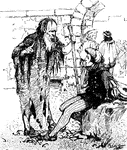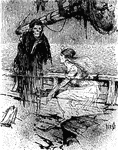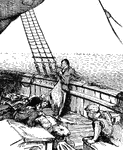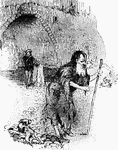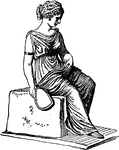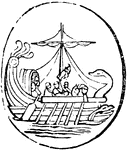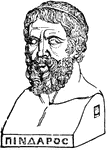
Bust of Pindar
"Pindar, though the contemporary of Simonides, was considerably his junior. He was born either at, or…

Bust of Herodotus
"The first writer who deserves the name of a historian is Herodotus, hence called the Father of History.…
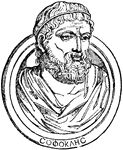
Sophocles
"Sophocles, the younger rival and immediate successor of Aeschylus in the tragic art, was born at Colonus,…
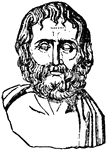
Euripides
"Euripides was born in the island of Salamis, in B.C. 480, his parents having been among those who fled…
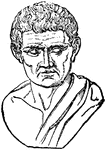
Aristotle
"Aristotle was born in 384 B.C., at Stagira, a seaport town of Chalcidice, whence he is frequeently…
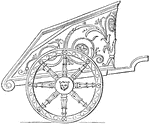
Chariot
"Arms and a chariot are here assigned to June through not properly a warlike goddess. The idea itself,…
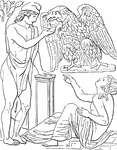
Ganymede and Eagle
"From an ancient sarcophagus, represents Ganymede giving drink to the eagle, or bird of Jobe, and Hebe…

Coin of Minerva
"Minerva is often represented on gems and coins, hurling the thunderbolts of Jove. The following cut,…

Juno
"The following cut is taken from the Vatican Juno found in the ruins of Lorium." — Anthon, 1891
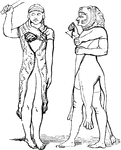
Greek soldiers
"'Exulting in the tawny covering of a she-wolf, such as his foster-parent was.' Alluding to the custom…
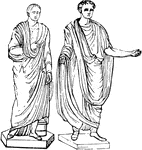
Roman Togas
"The following cuts represent, the first more ancient, and the second the later mode of wearing the…

Temple of Jupiter
"The door in front of a temple, as it reeached nearly to the ceiling allowed the worshippers to view…

Ancient bows
"Represents two forms of the bow; the upper, the Scythian or Parthian bow enstrung, agreeing with the…
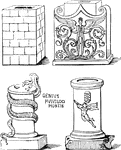
Altars
"Altars were either square or round. Specimens of both kinds are here given from ancient sculptures."…
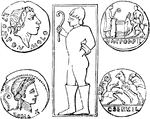
Sculpture and coins
"The figure in the middle of the following illustration is from a most ancient specimen of Etruscan…
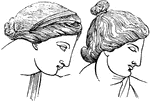
Venus and Diana
"Venus and Diana are generally represented with their hair dressed in the simple style of the young…

Crested helmets
""The crested Achilles was pressing on in his chariot." Some idea of the ancient crests may be formed…
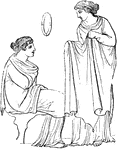
Peplus
"The peplus was a shawl which commonly formed part of the dress of females. It was often fastened…
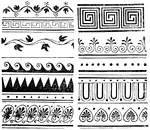
Assorted ornaments
"The following cut shows specimens of ancient borders to veils and other articles of female attire."…
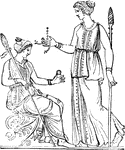
Women with necklaces
"It is a very common error to translate monile baccatum, "a pearl necklace". The ornament of…
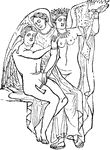
Women with necklaces
"It is a very common error to translate monile baccatum, "a pearl necklace". The ornament of…

Lampadephoria
"Lampadedromia, torch-race, and often simply, Lampas, was a game common throughout Greece. At Athens…
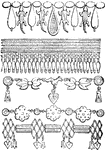
Ancient necklaces
"The following, also, are specimens of other ancient necklances. The first, small golden lizards alternate…

Lucerna
"An oil lamp. The Greeks and Romans originally used candles; but in later times candles were chiefly…

Lucerna
"An oil lamp. The Greeks and Romans originally used candles; but in later times candles were chiefly…

Lyra
"A lyre, one of the most ancient musical instruments of the stringed kind. The Greeks attributed the…

Herculaneum
"In the following we have back and front views of the heads of statues from Herculaneum, on which we…
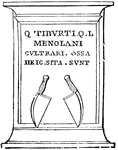
Tombstone of a cultrarius
"The preceding cut represents the tombstone of a cultrarius, or the individual who slew the…
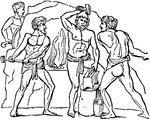
Malleus
"A hammer, a mallet. In the hands of the farmer the mallet of wood served to break down the clods and…

Pala
"The spade was but little used in ancient husbandry, the ground having been broken and turned over by…
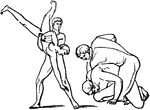
Pancratium
"An athletic game, in which all the powers of the fighter were called into action. The pancratium was…
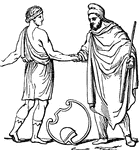
Pedum
"A shepherd's crook. On account of its connection with pastoral life, the crook is often seen in works…

Pelta
"A small shield, Iphicrates, observing that the ancient Clipeus was cumbrous and inconvenient, introduced…

Pileus
"Any piece of felt; more especially, a skull-cap of felt, a hat. These seems no reason to doubt that…
Pons Cestius
"A bridge. As the rivers of Greece were small, and the use of the arch known to them only to a limited…

Pons Aelius
"A bridge. As the rivers of Greece were small, and the use of the arch known to them only to a limited…
Pons Ariminum
"A bridge. As the rivers of Greece were small, and the use of the arch known to them only to a limited…
Pons Trajan
"A bridge. As the rivers of Greece were small, and the use of the arch known to them only to a limited…
Pyxis
"A casket, a jewel-box. Quintilian produces this term as an example of catachresis, because it properly…
Retis
"A net. In hunting it was usual to extend nets in a curved line of considerable length, so as in part…

Reticulum
"A caul or coif of network for covering the hair, worn by women during the day as well as the night.…
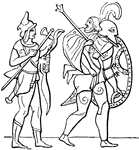
Sceptrum
"Sceptrum, which originally denoted a simple staff or walking stick, was emblematic of station and authority.…
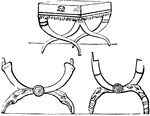
Sella
"Sella, the general term for a seat or chair of any description. Sella Curulis, the chair of state.…

Sella
"Sella, the general term for a seat or chair of any description. Sella Curulis, the chair of state.…

Sella
"Sella, the general term for a seat or chair of any description. Sella Curulis, the chair of state.…

Sella
"Sella, the general term for a seat or chair of any description. Sella Curulis, the chair of state.…

Signa Militaria
"Signa Militaria, military ensigns or standards. The most ancient standard employed by the Romans is…

Speculum
"Speculum, a mirror, a looking-glass. The looking-glasses of the ancients were usually made of metal,…

Stadium
"A Greek measure of length, and the chief one used for itinerary distances. It was equal to 600 Greek…
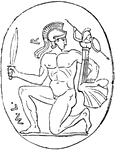
Diomede
"The following cut, from an ancient gem, represents Diomede in the act of bearing away the Palladium."…

Greek soldier
"The early Greeks used a very short sword, as may be seen from the preceding cut. The ancient Homeric…
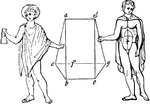
Chlamys
"The chlamys was a species of cloak or scarf, oblong instead of square, its length being generally about…


